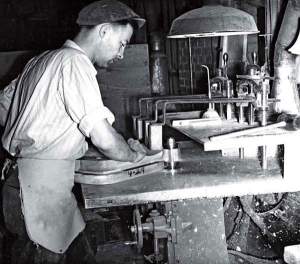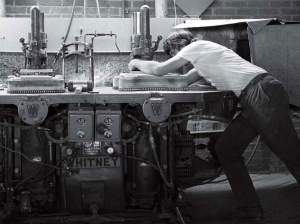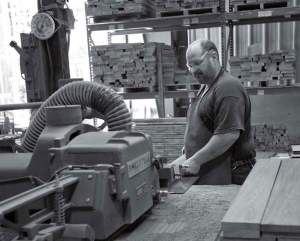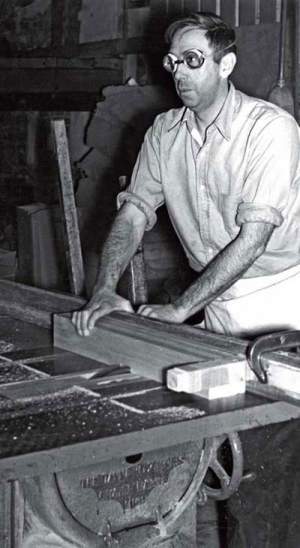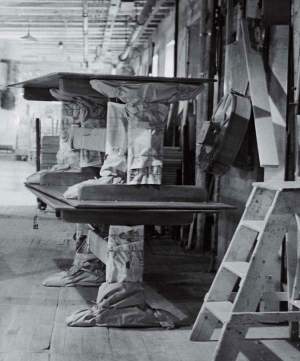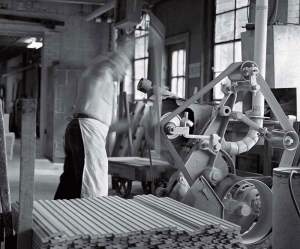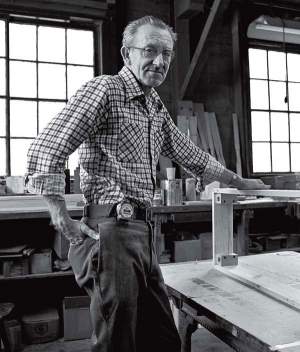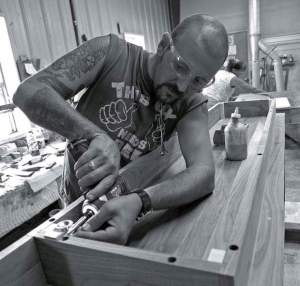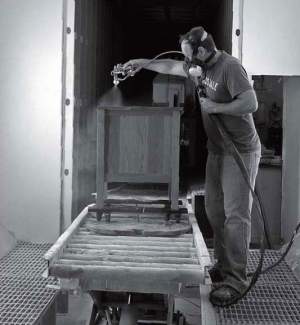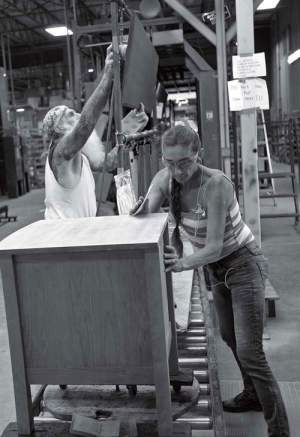Things were simpler when we were kids, right? Culture certainly was, before 457 channels and the internet and smart phones. Probably global politics were, too. The Cold War – Rocky vs. Ivan Drago – seems almost quaint now, and a lot easier to wrap your mind around than the nuances of a place like Syria.
The wood economy was definitely simpler – I’m sure of it. Where I grew up, we have mountains full of rock maple and beautiful red-hearted yellow birch, and the economy based around that wood used to be pretty linear. The woodlot owners, timber companies, and wood manufacturing companies (many of which owned extensive acreage) grew it. The loggers cut it, and some of the wood ended up at a local mill, like Cushman Furniture in North Bennington, Vermont. Cushman turned boards into furniture, including coat racks (stylish in the 1890s), smokers (all the rage in the 1920s), and breakfast suites (a must have in the 1960s). Afterwards, the finished wood product went to a retailer, then a consumer. To this day, you can walk into a house in Southern Vermont and see a Cushman end table or bed.
This economic pyramid, with its various levels building on one another, looked just like the ecosystem pyramids from biology class, where the plants on the bottom feed the bugs, which feed the birds, which feed the foxes. And just like in ecology, things get even more interconnected when you look beyond the trophic levels and consider the niches. Back in the day, Cushman nourished not just loggers and furniture retailers but fabric mills, chemical finishing firms, hardware and machinery producers, designers, shopkeepers, landlords, ad agencies, magazines, accountants, insurance salesmen, consultants, and on and on.
Cushman is long gone. It turned into Green Mountain Furniture in 1971, then National Hanger in the 1980s. Hanger still exists but works with plastic (its line of wooden clothes hangers are imported from China). A big chunk of the manufacturing sector in Bennington today revolves around aerospace composites, which furthers the idea that things just ain’t like they used to be.
Hard Times
If you live in Boonville, New York, Andover, Maine, or Island Pond, Vermont, this will all sound familiar – Ethan Allan furniture has laid off workers and closed plants and/or sawmills in each of these towns in the recent past. If you live anywhere in the Northeast you’ve probably felt ripples from the decline of the wood manufacturing industry. According to Mike Dugan, author of The Furniture Wars, the U.S. furniture manufacturing industry has lost $50 billion in market share to Asian countries over the last 10-15 years, resulting in over 300 plant closures in the eastern hardwood region.
Globalization is not the only culprit here, but it provides some of the most head-shaking moments. “At one point in 2005, it was cheaper for a New York sawmill owner I knew to ship a trailer full of kiln-dried hardwood lumber to China than it was to send it to North Carolina,” said Collin Miller, Director of Wood Product Initiatives for the Northern Forest Center, which coordinates the Regional Wood Products Consortium across northern New England and New York state. The trade imbalance has improved since the federal government imposed a 25 percent tariff on hardwood bedroom furniture from China in 2005, but over 70 percent of the un-upholstered wood furniture in the U.S. is still made someplace else. (An industry white paper entitled “Reinventing The Hardwood Industry One Company at a Time” opens with the phrase: “At one time the term colony was loosely defined as any geographic region that exported raw materials to the home country and then purchased those materials back as value added products. By that economic measure, the U.S. is quickly becoming a colony of Asia.”)
Plants continue to close, the most recent being Brown Street Furniture/Vermont Tubbs in Whitefield, New Hampshire, which closed last summer, leaving 40 people without jobs.
The furniture industry has been the hardest hit, but all wood manufacturing in our region is facing similar global pressure. Wood can be produced more quickly and more cheaply elsewhere – especially in places where forestry practices are lax, or in areas where plantation style forests are the norm. And imagine being a domestic wood manufacturer in a global marketplace, where your competition doesn’t have to comply with any of the worker safety, worker health, or environmental regulations you do and can pay employees a fraction of the going wage for millwork. Oh, and doesn’t have to heat a factory seven months out of the year.
These “institutional challenges,” as they’re called in industry parlance, are certainly contributing factors to the industry’s decline, but there are also self-inflicted wounds. Way back in 1994, the Northern Forest Lands Council issued a report saying: “Marketing of forest-based products and services by businesses [in the Northeast] is not sophisticated. Reasons include little long range planning; not responsive to market trend changes; regional coordination and marketing lacking; and unresponsive to rapidly changing consumer tastes.”
The booming late 1990s and 2000s bought a lot of not-very innovative companies some time, but the housing collapse and subsequent recession meant the end of the line in a lot of cases. “The people in the sawmill or secondary solid wood products sectors who have not innovated in the last 10 years are probably gone,” said Charlie Levesque, an author of the Lands Council report.
Just because they don’t make phonographs anymore doesn’t mean people stopped listening to music.
The notion of destruction and subsequent regeneration is at the core of both nature and capitalism. Neither is ever stationary. Species, businesses, adapt to the changing landscape around them. Or they don’t. This isn’t meant to sound callous in the face of layoffs and declining employment numbers that have profound effects on local families and businesses. But a clinical look does allow us to see how the industry is adapting to major shifts in both manufacturing and marketing.
“There are two main competitive advantages that today’s domestic wood products manufactures can exploit to stay competitive,” said Miller. “Their ability to have a relationship with a U.S. customer, which enables them to tailor their products to add more customer value. And quick shipping – the fact that they’re based in the largest market in the world.”
China has its own problems – not the least of which are rising material, transportation, distribution, and production costs. Art Raymond, a wood products manufacturing consultant based in Raleigh, North Carolina, says that ten years ago the ratio between Chinese and American wages was 1:25. Now it’s something like 1:7. And “wages in China are increasing about 15 percent annually,” said Raymond. “That translates to a doubling in five years. Unless wages here grow faster, the gap between a Chinese plant and one in the U.S. will narrow further.”
It’s also important to remember that globalization is a two-way street. In 2008, China exported $9.2 billion in wood products – and imported $8.2 billion. American exports of both lumber and wood products have increased substantially from 2008 to 2013 (11 percent and 17 percent respectively). And industry insiders report that the “Made in the USA” label on domestically-produced wood products has and should continue to have status abroad. One estimate holds that by 2030 there could be 3.2 billion middle class consumers in Asia (a six-fold increase), which is a lot of potential customers.
Bill Luppold, a Forest Service economist, says that while much of the wood industry has been “clobbered” in the past decade, things may be starting to improve domestically. “We’re seeing increased international trade in lumber and logs and flooring production,” said Luppold. Anecdotally, he’s noticed that small cabinet makers seem to be busy, an insight that doesn’t show up in employment numbers, but may be reflected in the fact that a large cabinet component mill in the Midwest is humming.
The housing market has picked up, which usually portends a high tide for all facets of the wood industry. (The general wood products sector usually lags a few years behind the rise and fall of the home building sector.)
Levesque’s work mostly deals with the primary sector of the wood business in the Northeast (meaning the first people who touch the wood: lumber, wood energy, and pulp producers). He says that the sawmill sector has rebounded significantly since its bottom in 2009-10. “For those mills in the Northeast that made it through the recession, production is screaming. Many mills have added shifts or are working 24/7,” he said.
There’s also been an uptick in the secondary sector. Miller, through his work with the Regional Wood Products Consortium, helps manufacturers in the Northeast innovate, and he’s seen a number of recent success stories. A few cherry-picked examples include Newport Furniture Parts in Newport, Vermont, which overhauled the company in 2011, instituted a new lean manufacturing ethos, and saw a 25 percent growth in sales in 2012, and Maine Wood Concepts, a Maine wood turning company that recently acquired a line of wooden gourmet kitchen products and hired over 40 people.
One of the more dramatic recent success stories is Timeless Frames, in Watertown, New York, which was nearly bankrupt in 1999 and had 3 employees; a new management team implemented a business model using digital customization of picture frames and grew sales in the new division to $10 million in 18 months. Today they employ nearly 300 people and use 2 million board feet of northern hardwoods to make wall-hanging picture frames in direct competition with importers.
Another interesting thing to note is that while employment has dropped significantly in both the primary and secondary sectors, production losses have been more modest. According to government agencies that track this sort of thing, the primary side lost 34 percent of its workforce between 2001 and 2011, but productivity (as measured in gross domestic product) was only down 7 percent. The secondary side lost 40 percent of its workforce in 10 years, but productivity only fell by 21 percent. Current numbers aren’t available, but those in the know say production has increased since 2011.
Talk to enough people involved in this line of work and you’ll come to realize that there is no universal experience. Some manufacturing companies have closed. Others have expanded or retooled, in every sense of the word. What everyone seems to agree on is that the boom years of the mid-2000s were an unsustainable bubble. What we’re in now, and what we’re moving towards, is the new normal. And everyone is still trying to get a handle on what that means.
Over the next four issues we’re going to visit four secondary manufacturing plants across our region that have adopted strategies they hope will make their businesses strong and competitive. Our first stop is Lyndon Furniture, in Lyndonville Vermont. Continue reading: Bucking the Trend at Lyndon Furniture.



